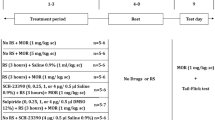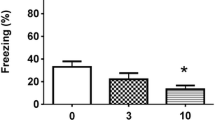Abstract
The role of associative factors in the effect of 15 min/day of restraint stress on morphine-induced behavioral sensitization was examined. Male rats were initially given seven systemic (10 µg/kg, IP) or intraventral tegmental area (VTA, 5 mg/side) injections of morphine, and were exposed to restraint, either just prior to drug injection (Paired-Stress) or 24 h after injection (Unpaired-Stress), or to no restraint (Control). In subsequent tests for behavioral sensitization to low doses of morphine (0.75 or 3.0mg/kg, IP), animals in the Paired-Stress condition were more active than animals in the Unpaired-Stress or Control conditions. These results indicate that temporal and possibly associative factors may contribute to stress-induced changes in sensitization to the behavioral activating effects of opioids.
Similar content being viewed by others
References
Abercrombie EA, Keefe KA, Difrischia DS, Zigmond MJ (1989) Differential effect of stress on in vivo dopamine release in striatum, nucleus accumbens, and medial frontal cortex. J Neurochem 52:1655–1658
Babbini A, Gaiardi M, Bartoletti M (1975) Persistence of chronic morphine effects upon activity in rats 8 months after ceasing the treatment. Neuropharmacology 14:611–614
Deroche V, Piazza PV, Casolini P, Maccari S, Le Moal M, Simon H (1992) Stress-induced sensitization to amphetamine and morphine psychomotor effects depend on stress-induced corticosterone secretion. Brain Res 598:343–348
Deutch AY, Roth RH (1990) The determinants of stress-induced activation of the prefrontal cortical dopamine system. Prog Brain Res 85:367–403
Deutch AY, Tam SY, Roth RH (1985) Footshock and conditioned stress increase 3,4-dihydroxyphenylacetic acid (DOPAC) in the ventral tegmental area but not substantia nigra. Brain Res 333:143–146
Dib B, Duclaux R (1982) Intracerebroventricular self-injection of morphine in response to pain in rats. Pain 13:395–406
Di Chiara G, North RA (1992) Neurobiology of opiate abuse. Trends Pharmacol Sci 13:185–193
Doherty MD, Gratton A (1992) High-speed chronoamperometric measurements of mesolimbic and nigrostriatal dopamine release associated with repeated daily stress. Brain Res 586:295–302
Imperato A, Puglisi-Allegra S, Casolini P, Angelucci L (1991) Changes in brain dopamine and acetylcholine release during and following stress are independent of the pituitary-adrenocortical axis. Brain Res 538:111–117
Iwamoto ET, Way EL (1977) Circling behaviour and stereotypy induced by intranigral opiate microinjections. J Pharmacol Exp Ther 203:347–359
Joyce EM, Iversen SD (1979) The effect of morphine applied locally to mesencephalic dopamine cell bodies on spontaneous motor activity in the rat. Neurosci Lett 14:207–212
Kalivas PW, Abhold R (1987) Enkephalin release into the ventral tegmental area in response to stress:modulation of mesocorticolimbic dopamine. Brain Res 414:339–348
Kalivas PW, Duffy P (1987) Sensitization to repeated morphine injection in the rat:possible involvement of A10 dopamine neurons. J Pharmacol Exp Ther 241:204–212
Kalivas PW, Stewart J (1991) Dopamine transmission in the initiation and expression of drug- and stress-induced sensitization of motor activity. Brain Res Rev 16:223–244
Leyton M, Stewart J (1990) Preexposure to foot-shock sensitizes the locomotor response to subsequent systemic morphine and intranucleus accumbens amphetamine. Pharmacol Biochem Behav 37:303–310
Pellegrino LJ, Pellegrino AS, Cushman AJ (1979) A stereotaxic atlas of the rat brain. Plenum, New York
Shaham Y (1993) Immobilization stress-induced oral opioid self-administration and withdrawal in rats:role of conditioning factors and the effect of stress on “relapse” to opioid drugs. Psychopharmacology 111:477–485
Shaham Y, Stewart J (1994) Exposure to mild stress enhances the reinforcement efficacy of intravenous heroin self-administration in rats. Psychopharmacology 114:523–527
Shaham Y, Alvares K, Nespor SM, Grunberg NE (1992) Effect of stress on oral morphine and fentanyl self-administration in rats. Pharmacol Biochem Behav 41:615–619
Shaham Y, Klein LC, Alvares K, Grunberg NE (1993) Effect of stress on oral fentanyl consumption in rats in an operant self-administration paradigm. Pharmacol Biochem Behav 46:315–322
Stewart J (1992) Neurobiology of conditioning to drug abuse. Ann NY Acad Sci 654:335–346
Stewart J, Vezina P (1991) Extinction procedures abolish conditioned stimulus control but spare sensitized responding to amphetamine. Behav Pharmacol 2:65–71
Stinus L, Koob GF, Ling L, Bloom FE, Le Moal M (1980) Locomotor activation induced by infusion of endorphins into the ventral tegmental area:evidence for opiate-dopamine interaction. Proc Natl Acad Sci USA 77:2323–2327
Vezina P, Stewart J (1984) Conditioning and place-specific sensitization of increases in activity induced by morphine in the VTA. Pharmacol Biochem Behav 20:925–934
Wise RA, Bozarth MA (1987) A psychomotor stimulant theory of addiction. Psychol Rev 94:469–492
Author information
Authors and Affiliations
Rights and permissions
About this article
Cite this article
Shaham, Y., Stewart, J. & Kelsey, J.E. Temporal factors in the effect of restraint stress on morphine-induced behavioral sensitization in the rat. Psychopharmacology 117, 102–109 (1995). https://doi.org/10.1007/BF02245104
Received:
Revised:
Issue Date:
DOI: https://doi.org/10.1007/BF02245104




